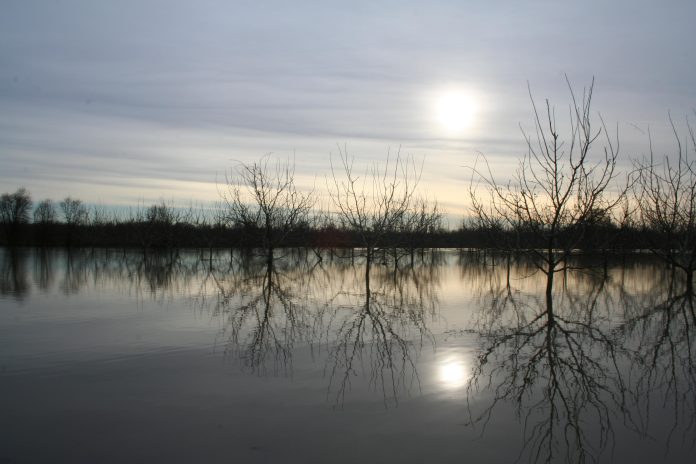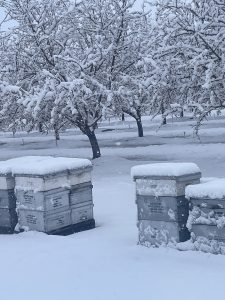
March charged in like a lion with atmospheric rivers that carried heavy snow, rain and flooding into California, impacting nut growers up and down the state.
The weather has been crazy, according to Matt Anchordoguy, a nut grower in Tehama County. Anchordoguy grows 270 acres of almonds, 1100 acres of walnuts and 500 acres of oil olives. Anchordoguy said the North State has seen everything in 2023 from hail as much as 4 inches deep in some areas, several inches of snow and buckets of rain with 4 to 5 inches predicted in mid-March.
With the predicted rain, flooding was also a concern as temperatures warmed, which is bad news for growers worried about disease.
“The river is supposed to come up 11 feet they’re saying this weekend, and that might flood into some orchards,” Anchordoguy said, and he has orchards in Los Molinos that are at risk of flooding.
“When it gets to the flood stage, it just starts creeping in,” Anchordoguy said, and he’s right on the edge of the river.
Almond Bloom
The almonds opened later in 2023 (February 11 to 12) compared to 2022, when they opened on February 3. “We weren’t complaining,” Anchordoguy said. “We’re thinking that’s perfect because we had freeze damage last year, and that kicked the crop down a little bit.”
When the buds started opening this year, it was slow because of the cool ground temperatures and ground saturation.
“They didn’t just pop right open in one or two days, but the bees started working pretty good on the 14th and 15th, then the wind and cold temps kept them in the hives around the 16th and 17th,” Anchordoguy said, adding that was most likely all the bee days his orchards got.
On the positive side, the pollinators and the Nonpareils opened at the same time. “Sometimes, the Monterey’s don’t open up until a couple of days after the Nonpareils, but they were all open; the whole field was open all at the same time,” Anchordoguy said, which allowed the bees to pollinate what was open.
But the weather wasn’t done with him. “On February 24, we had 4 to 6 inches of snow,” he said, adding one of his new orchards where the tree cover is 16 inches high had snow halfway up the covers.
“We only need 15% of the pollinated fruit to make it, so we’re probably okay,” Anchordoguy said, adding he estimates 70% of the blossoms were already opened by the time it snowed.
Surprisingly, Anchordoguy has seen no damage from the snow. “The temps didn’t go below 31 degrees [F], so we don’t think there’s any damage. Everything looks good.”
Anchordoguy had some cold temperatures in early March, but there wasn’t any damage. Turns out that frost event was warmer than expected (29 to 30 degrees F).

Rain Challenges
Rain brings on more challenges, particularly warm rain because it brings disease. “We have to spray our fungicides. We’re already on our second fungicide, and that’s just expensive with the way the market is,” Anchordoguy said.
“Last year, we got away with probably just two fungicides, but this year we’re already on our second one, and we’re going to be spraying every two weeks,” he continued, because the rain isn’t letting up.
To add to an already difficult start to the season, the frost event in early March was when Anchordoguy was supposed to spray, but he had to turn on the sprinklers instead to raise the temperatures in the orchards. This resulted in additional costs because he had to pay helicopters to make the spray application instead.
“We couldn’t spray with our ground rigs which costs less,” Anchordoguy said, and because the grounds are so saturated, he’ll probably have to use aerial applications for future treatments.
“It’s just that extra added expense when we’re trying to cut expenses everywhere we can. But you still want to push a good, healthy crop in case the market turns around, and that means you’ve got to keep the trees healthy,” Anchordoguy said.
“We’ll be spraying another systemic nutrition and a fungicide,” he said, to protect the almond trees from anthracnose and jacket rot.
Using ariel sprays versus a ground spray means it doesn’t get up in the canopy, which is why Anchordoguy is using systemics.
“With the helicopter, you’re only getting 20 gallons of water per acre with the chemical, whereas with the ground rigs, we’re getting 100 gallons. So, we’re spraying it up through the tree from the bottom and then it’s settling back down from the top,” Anchordoguy said, which is why he gets better coverage with the ground rig.
These diseases aren’t so much yield loss as tree health. “That’s why you’ve got to spray,” he said.
If weather conditions continue, there will be blight sprays for the walnuts, too. “That’ll be depressing at 30 cents a pound for walnuts,” Anchordoguy said.
“We’re going to keep farming the best we can. I don’t want the blight to get us,” he said, but if he doesn’t treat for these diseases and prices turn around next year, the trees won’t be at full production.
“You’ve got to look for the positive, and look to the future, and be ready because there’s going to be opportunity and you want the trees to be healthy,” Anchordoguy said.
Almond Market
The last three years have been challenging between low prices and high input costs, chemicals and diesel prices, especially, Anchordoguy said.
The almond market is currently in the toilet, and he’s not hearing much good news on pricing other than it’s come up slightly.
“We heard Nonpareils were down at $1.40 to $1.45 a pound and they’ve come up to $1.50 a pound, so it may be headed in the right direction. I think we’ve probably hit bottom just because this is the first year the actual acreage has not grown. It’s either flat or it’s gone down, and we’re expecting a lighter crop, hopefully,” Anchordoguy said, which will help put supply in line with demand.

Walnuts
Walnut prices remain bleak. “It’s depressing to say the least,” Anchordoguy said. “We just have so many problems. I mean, it’s the ports, it’s the value of the dollar, it’s inconsistency in our pricing (too many handlers), people that have to dump product. Even our customers in Vietnam, South Korea and Japan are saying, ‘Why are you even selling these walnuts so cheap?’ They could pay twice as much no problem.”
These buyers don’t want to inventory more than two weeks’ worth of kernels if the price is going to drop every month or every two weeks, he continued. “We need to stay at a consistent price,” Anchordoguy said.
The good news with walnuts is they aren’t impacted by the flooding because they are still dormant since it’s been so cool.
“The walnut trees this year should just explode when they bloom. I think they’re going to feel great because they’ve been asleep since November with winter temperatures in the high 30s to low 50s. The walnuts are definitely sound asleep right now. They’re not going to push for a while, and they’ll probably push a little bit late, which is what we need. This deep moisture, these cool temps is the best thing for the walnuts,” Anchordoguy said.
Even with all the challenges, Anchordoguy still believes things will turn around and there will be better days for growers in the future.
Winter Storm Damage
If winter storms, snow, hail, wind, extreme weather and temperatures have caused the tree or your bloom/crop damage or loss, it’s important to know your options. First, notify and document.
Notify your insurance agent, County Ag Commissioner and County USDA Farm Service Agency of any damages you see or experience on your own operation.
Document damages with pictures (dated) or a report by your agronomist or PCA.
It may be too early to tell specifically the extent of your damages or loss; however, it is important to notify proper offices and document the type and location of damages or losses you experience. To go on the record having reported damages/loss and request a disaster declaration from the county (Ag Commissioner) and county committee (FSA).
This information will be critical as the Almond Alliance pursues disaster relief and recovery resources from state and federal agencies.
Please feel free to send pictures or estimates of damages and loss to the Almond Alliance.
Resources:
www.farmers.gov
Disaster Assistance Tool, (www.farmers.gov/protection-recovery/disaster-tool): Learn about what options are available to you.
USDA TAP (www.fsa.usda.gov/programs-and-services/disaster-assistance-program/tree-assistance-program/index): Damages and loss to the tree or vine
USDA Micro-Load (www.fsa.usda.gov/programs-and-services/farm-loan-programs/microloans/): Quick low-interest loans up to $50,000
Almond Alliance: Nicole Gault (209-300-7140 or NGault@AlmondAlliance.org); Aubrey Bettencourt (Aubrey@AlmondAlliance.org)










